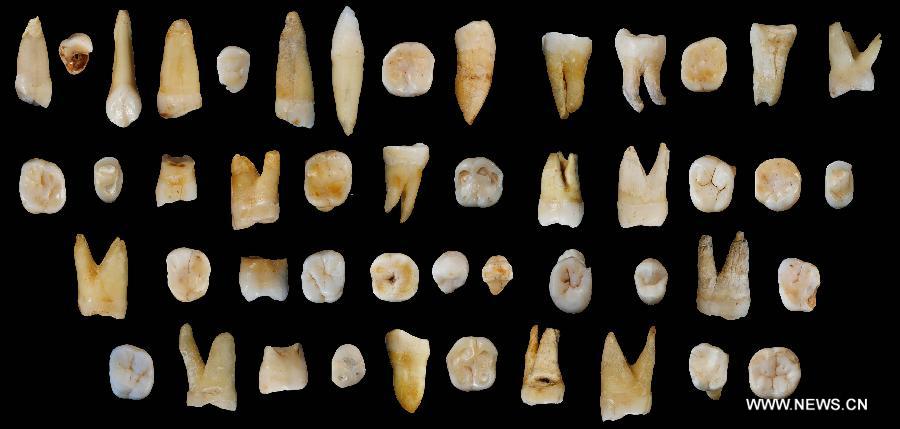

Photo provided by the Institute of Vertebrate Paleontology and Paleoanthropology under the Chinese Academy of Sciences shows tooth fossils found in Daoxian county in central China's Hunan Province. These tooth fossils indicate the early form of modern homo sapiens appeared in the region more than 80,000 years ago. The 47 fossils, found in Daoxian county, date back from 80,000 to 120,000 years and are believed to be the oldest remains of a completely modern form scientists have known in the east Asia region, the study's leading scientists said on Oct. 15, 2015. (Xinhua)
Tooth fossils found in a county in central China's Hunan Province indicate the early form of modern homo sapiens appeared in the region more than 80,000 years ago.
The 47 fossils, found in Daoxian county, date back from 80,000 to 120,000 years and are believed to be the oldest remains of a completely modern form scientists have known in the east Asia region, the study's leading scientists said on Thursday.
The research, conducted by Chinese and foreign institutes since 2010, was led by Liu Wu and Wu Xiujie from the Institute of Vertebrate Paleontology and Paleoanthropology under the Chinese Academy of Sciences (CAS) as well as Cai Yanjun from the CAS's Institute of Earth Environment.
Researchers found that sizes of the teeth in Daoxian are remarkably smaller than those with humans in the mid and late Pleistocene era, indicating that they belong to much earlier humans.
However, their simple occlusal surface, short and thin roots and crown shapes are typical for modern Homo sapiens, according to the scientists.
Cai said the scientists used uranium-series dating, carbon-14 testing and surrounding animal analysis and determined that these fossils have a history of about 80,000 to 120,000 years.
Previous studies indicated that humans with modern features appeared in west Asia and Europe as early as about 50,000 years ago.
Remains of Homo sapiens dating before 45,000 years ago, which are found in the Asian-Pacific region and are in good condition, are very rare. The latest finding gives more evidence of the earliest presence of modern humans in this region, Wu Xiujie said.
These results will also help the study of origin and migration of modern humans in the region.
This latest finding was published on the Thursday edition of the journal Nature. (Xinhua)

86-10-68597521 (day)
86-10-68597289 (night)

52 Sanlihe Rd., Xicheng District,
Beijing, China (100864)

